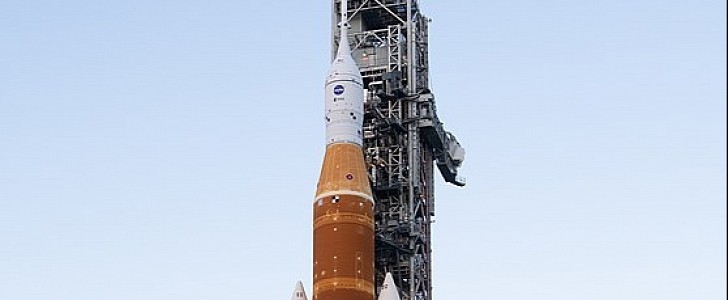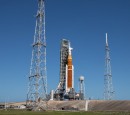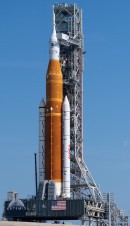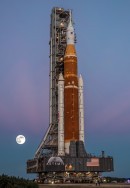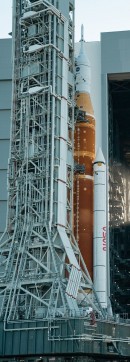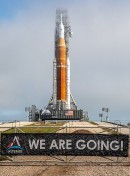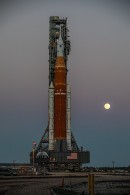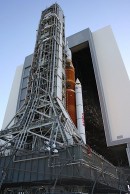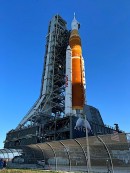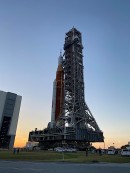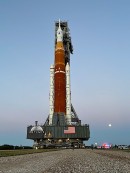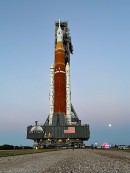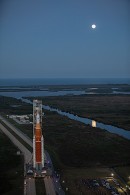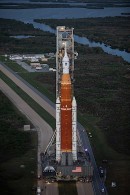At 9 a.m, on the morning of September 26th, NASA's weather analysis team declared a Hurricane Condition IV status on an incoming tropical storm named Ian. In the wake of back-to-back launch scrubs owing to issues with the SLS rocket's number three main engine and subsequent hydrogen cryo-fuel leak from its main tank, it's another savage blow for NASA's manned Moon program.
With the now Hurricane Ian expected to make landfall somewhere within the region of Central Florida between Wednesday, September 28th and 29th, estimates suggest the bulk of the storm will impact the western portion of the state closer to the City of Tampa instead of closer to where the Kennedy Space Center is situated, approximately 46.5-miles (75-km) from Orlando. Meanwhile, SLS engineering personnel are scrambling to mount the 320-plus-foot-tall rocket back onto its gargantuan transport vehicle for the day-long trip back to the Vehicle Assembly Building with considerable haste.
Since August 17th, the SLS booster rocket and its payload of a single Orion Command Capsule with its ESA Service Module have sat at KSC's Launch Complex 39B, a stone's throw away from LC-39A, where its Saturn V ancestor ferried 12 American men to the Moon's surface during the Apollo missions. In that time, tens, if not hundreds, of thousands of people have flocked to Cape Canaveral, Florida, for their shot at witnessing history. To see an American rocket launch a human-rated spacecraft capable of landing on other heavenly bodies.
But at every step in the road since the first Artemis I launch attempt on August 29th, a series of unfortunate events have occurred with the mighty $23 billion SLS Block 1 rocket capable of launching in the neighborhood of 60,000 lbs (27 tons) into a trans-lunar injection bound for the Moon. But as of late September 2022, a rocket theoretically capable of beating the Saturn V in terms of raw thrust is currently generating zero pounds of thrust.
From the outside looking in, it feels like nothing is going right for NASA. All the while, nations including Russia, China, India, Saudia Arabia, the UAE, and even South Korea have at least expressed interest in their own manned Lunar landings. Some, like China and Russia, have booster rockets theoretically capable of getting the job done. Albeit without the same level of lifting power that NASA's SLS is projected to be capable of.
Having to watch the Artemis I SLS rocket travel back to its cradle yet might feel like a crippling blow to the program. But it's important to remember that launch scrubs are very common during launch attempts, no matter the location or flight conditions. Space Shuttle launched STS-61 and STS-73s, for example. Both scrubbed six times before finally lifting off. No doubt causing hotels from Cape Canaveral to Orlando to promptly extend their hotels and rental cars indefinitely. Such is the way things go when you're dealing with literal rocket science.
It's all too easy to mope and moan about Artemis I's unfortunate last few months. But it's important to remember that in spite of everything, all it takes is for things to go right once for the second space race to kick off in earnest. Despite how disorganized things may seem from the outside looking in, SLS's engineers know that playing it safe and "testing as you fly," as their engineers like to say, is better than a small flaw in the rocket leading to the loss of the rocket, and likely the entire Artemis program if this were to happen. We've waited 50 years for another moon launch. Another few months is not much to ask for everything to be done correctly. Let's have faith in NASA. They usually find a way to succeed in the end.
Since August 17th, the SLS booster rocket and its payload of a single Orion Command Capsule with its ESA Service Module have sat at KSC's Launch Complex 39B, a stone's throw away from LC-39A, where its Saturn V ancestor ferried 12 American men to the Moon's surface during the Apollo missions. In that time, tens, if not hundreds, of thousands of people have flocked to Cape Canaveral, Florida, for their shot at witnessing history. To see an American rocket launch a human-rated spacecraft capable of landing on other heavenly bodies.
But at every step in the road since the first Artemis I launch attempt on August 29th, a series of unfortunate events have occurred with the mighty $23 billion SLS Block 1 rocket capable of launching in the neighborhood of 60,000 lbs (27 tons) into a trans-lunar injection bound for the Moon. But as of late September 2022, a rocket theoretically capable of beating the Saturn V in terms of raw thrust is currently generating zero pounds of thrust.
From the outside looking in, it feels like nothing is going right for NASA. All the while, nations including Russia, China, India, Saudia Arabia, the UAE, and even South Korea have at least expressed interest in their own manned Lunar landings. Some, like China and Russia, have booster rockets theoretically capable of getting the job done. Albeit without the same level of lifting power that NASA's SLS is projected to be capable of.
Having to watch the Artemis I SLS rocket travel back to its cradle yet might feel like a crippling blow to the program. But it's important to remember that launch scrubs are very common during launch attempts, no matter the location or flight conditions. Space Shuttle launched STS-61 and STS-73s, for example. Both scrubbed six times before finally lifting off. No doubt causing hotels from Cape Canaveral to Orlando to promptly extend their hotels and rental cars indefinitely. Such is the way things go when you're dealing with literal rocket science.
It's all too easy to mope and moan about Artemis I's unfortunate last few months. But it's important to remember that in spite of everything, all it takes is for things to go right once for the second space race to kick off in earnest. Despite how disorganized things may seem from the outside looking in, SLS's engineers know that playing it safe and "testing as you fly," as their engineers like to say, is better than a small flaw in the rocket leading to the loss of the rocket, and likely the entire Artemis program if this were to happen. We've waited 50 years for another moon launch. Another few months is not much to ask for everything to be done correctly. Let's have faith in NASA. They usually find a way to succeed in the end.
